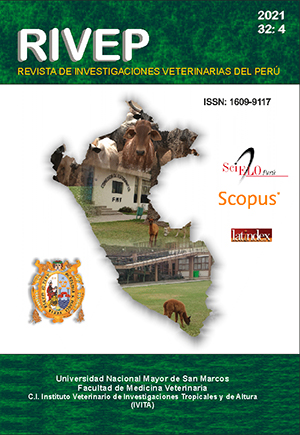Association between geographical altitude and incidence of wild rabies in cattle in the Apurimac region (2004-2015)
DOI:
https://doi.org/10.15381/rivep.v32i4.19270Keywords:
calendar time, bocine rabies, Desmodus rotundus, chiropters, altitude, AndesAbstract
Latin American cattle farming is affected by the wild rabies virus whose vector is Desmodus rotundus. In 2014, Apurímac, Peru registered the highest number of cases (n=75) The objective of the study was to determine the association between calendar time and wild bovine rabies outbreaks at different geographical altitudes in the Apurímac valley, between the years 2004 and 2015. Data from the SIGSA-SENASA (Integrated Animal Health Management System of the National Agrarian Health Service) on geographical altitude (m) and date of suspected outbreaks of wild rabies confirmed by direct immunofluorescence were analysed. The data were analysed using the Chi square test, t-Student, Spearman’s rho correlation and Poisson’s generalized linear models (GLM). In total, 525 suspected outbreaks were analysed (altitude range: 999-4586 m), finding differences for the number of outbreaks according to altitudes: high, medium and low (p<0.05). No correlation was found between outbreak altitude and calendar time or association between geographical altitude of the wild rabies outbreak with calendar time adjusted by seasonality and rearing system. It is concluded that there was an association between the number of cases of wild rabies and geographic altitude (p<0.05), without association with calendar time. Likewise, a negative association was observed with the average minimum temperature (p<0.01).
Downloads
Downloads
Published
Issue
Section
License
Copyright (c) 2021 Martín Equicio Pineda Serruto, Elisa María Vidal Cárdenas, Eric Humberto Callapiña Enríquez, Aldo Alim Valderrama Pomé

This work is licensed under a Creative Commons Attribution 4.0 International License.
AUTHORS RETAIN THEIR RIGHTS:
a. Authors retain their trade mark rights and patent, and also on any process or procedure described in the article.
b. Authors retain their right to share, copy, distribute, perform and publicly communicate their article (eg, to place their article in an institutional repository or publish it in a book), with an acknowledgment of its initial publication in the Revista de Investigaciones Veterinarias del Perú (RIVEP).
c. Authors retain theirs right to make a subsequent publication of their work, to use the article or any part thereof (eg a compilation of his papers, lecture notes, thesis, or a book), always indicating the source of publication (the originator of the work, journal, volume, number and date).










